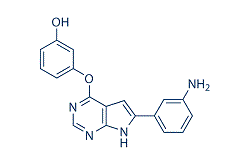| DC71176 |
TC-G 24
|
TC-G 24 (Compound 24) is a potent, selective glycogen synthase kinase-3β (GSK-3β) inhibitor with an IC50 of 17.1 nM. |
| DC7004 |
AR-A014418(GSK3β Inhibitor VIII)
|
AR-A014418 is a selective and effective GSK3β inhibitor with an IC 50 value of 104 +/- 27 nM; no significant inhibition on 26 other kinases. |
| DC1063 |
TWS119
|
TWS119 is a GSK-3β inhibitor with IC50 of 30 nM. |
| DC7680 |
IM-12
|
The GSK3β Inhibitor XIX, IM-12 is a selective GSK-3β inhibitor with IC50 of 53 nM, and also enhances canonical Wnt signalling. |
| DC4227 |
SB216763
|
SB 216763 is a potent and selective cell permeable ATP-competitive inhibitor of GSK3α with an IC50 value of 34 nM (similar potency for GSK3β). |
| DC9726 |
CP21 (CP21R7)
|
CP21R7 is a potent and selective GSK-3β inhibitor. |
| DC1023 |
CHIR-99021 (CT99021)
|
CHIR-99021 is a glycogen synthase kinase 3 beta inhibitor that has antiproliferative activity in vitro and in vivo. |
| DC9703 |
CHIR-99021 HCl
|
CHIR-99021 HCl is a potent and selective inhibitor of glycogen synthase kinase 3 beta (GSK-3β), a key enzyme involved in regulating various cellular processes, including metabolism, cell proliferation, and differentiation. By inhibiting GSK-3β, CHIR-99021 HCl modulates downstream signaling pathways, particularly the Wnt/β-catenin pathway, leading to significant biological effects both in vitro and in vivo. |
| DC7384 |
CHIR-98014
|
CHIR-98014 is a potent GSK-3α/β inhibitor with IC50 of 0.65 nM/0.58 nM, with the ability to distinguish GSK-3 from its closest homologs Cdc2 and ERK2. |
| DC7663 |
BIO
|
BIO (6-bromoindirubin-3'-oxime) is a specific inhibitor of GSK-3 with IC50 of 5 nM for GSK-3α/β, shows >16-fold selectivity over CDK5, also a pan-JAKinhibitor. |






















